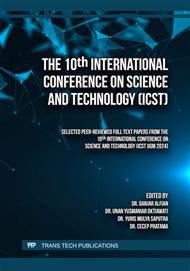p.134
p.142
p.153
p.162
p.175
p.185
p.192
p.202
p.214
Solar Hybrid Grain Dryer Machine
Abstract:
The grain drying process in Indonesia is usually done by conventional drying or by using a drying machine with a gas energy source. The conventional grain drying process is very dependent on weather conditions and is relatively long, while using a machine with a gas energy source the drying process only takes 5 hours. However, the energy used by the machine includes non-renewable energy. This research aims to design a grain dryer that combines two energy sources, namely solar heat as the main and renewable energy source and uses an electric heating heat energy source when in conditions of low sunlight intensity or at night with a maximum capacity of 35kg of wet grain. To achieve these goals, the methods used in this research are sequential hysteresis and the greenhouse effect. From the test results that have been carried out, the machine is able to dry wet grain with a moisture content of 26% to 14% during the day by using solar thermal energy takes 3 hours 45 minutes with an average electric power consumption of 0,0506 KWh. While drying grain using electric heaters at night takes 4 hours 15 minutes with an average electric power consumption of 1,0704 KWh.
Info:
Periodical:
Pages:
175-184
Citation:
Online since:
October 2025
Keywords:
Price:
Сopyright:
© 2025 Trans Tech Publications Ltd. All Rights Reserved
Share:
Citation:


